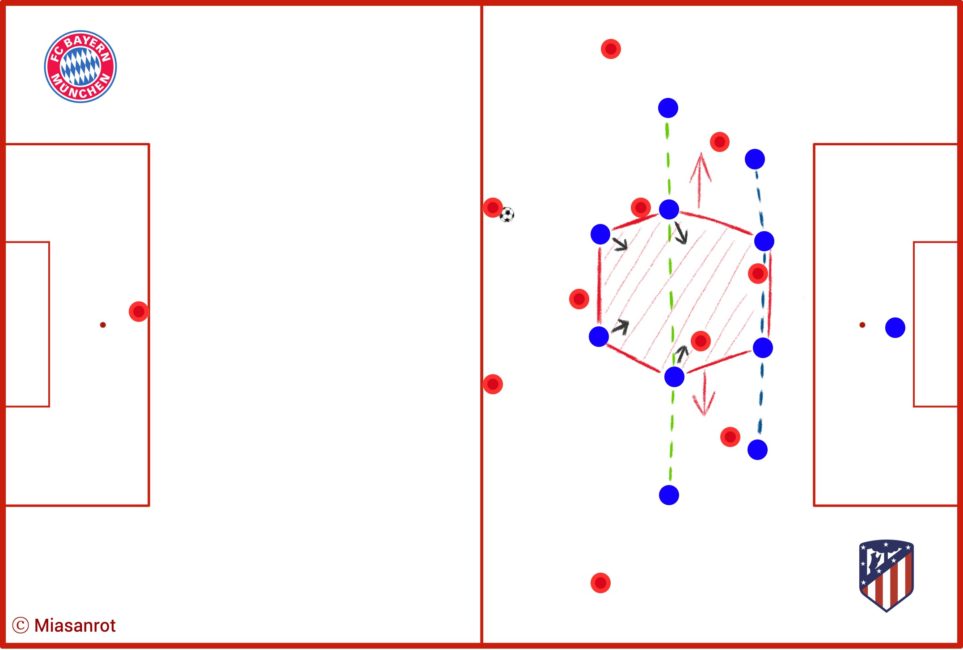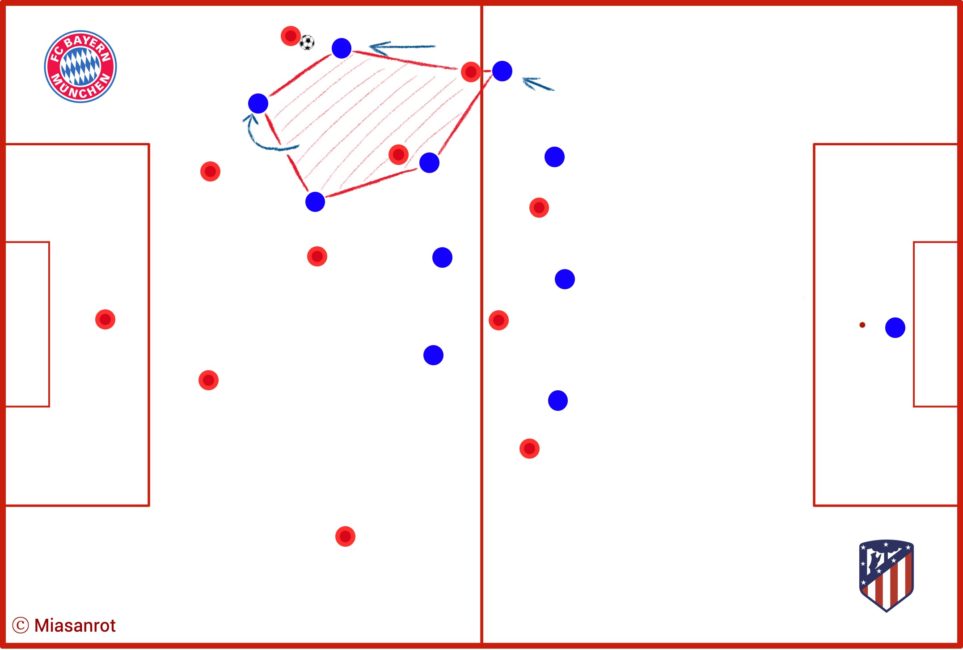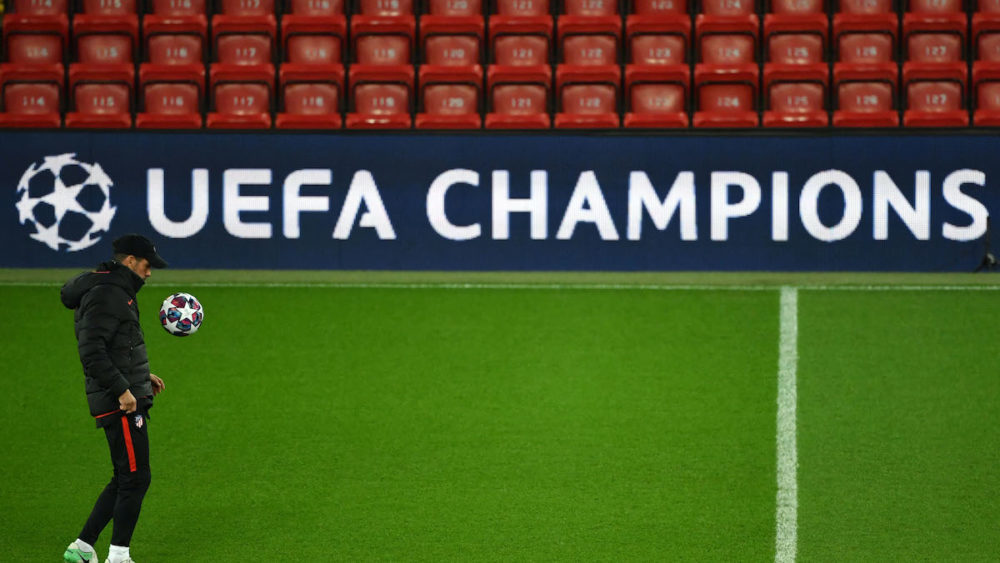Champions League Group Stage MD 01 – Atlético vs. Bayern
If you want to know what makes Diego Simeone so special, you should bring your patience. The coach has managed to establish Atlético Madrid among the European elite. He, not any of the players, is the star of the club because he manages to unite everyone behind a common goal. He has no time for players who put their self-interest above the interest of the team, put on airs or indulge in toxic relationships with their teammates.
Simeone is a volcano on the sidelines. One whose heart rate even in normal circumstances is often beyond any healthy limits. One who with his sideline gamesmanship frequently likes to test the patience of the fourth official. But Simeone is not just pure emotion. He is also a thinker and a philosopher of football – a side of him that is rarely noticed in public.
Atlético Madrid: Simeone’s work
Anyone who is able to not just stay at but be quite successful with just one club for nine years must have special abilities. Even the greatest coaches of our time can tell you a thing or two about what it is like when their methods and approaches no longer work. Coaching a top team over time often turns into a war of attrition, something that Pep Guardiola, for instance, became only too painfully aware of towards the end of his time at Barcelona and which he vowed he would avoid letting happen ever again. The same happened to Jürgen Klopp in Dortmund.
Simeone, however, seems to be the one exception to this rule who has so far somehow eluded this wear and tear. The reasons for this are probably so manifold and varied that it would take a book and not just an article to present them all. But a decisive element no doubt will be that he can always set new tactical stimuli that consistently keep challenging even long-time players like Koke.
Added to this is a constant revitalization of the squad over the years, which is just as necessary to avoid wear and tear. If Klopp and Guardiola have been the principal philosophers of attacking football of the last decade, Simeone is probably the coach one would equate with defensive perfection more than anyone else. He has turned defense into an art. This should by no means be underestimated when talking about the “volcano”, his heart rate or his penchant for an overbearing display of emotions.
The tough work on a possession game
Only last year, Atlético Madrid was again in a state of flux. It is often said that Simeone has not been able to repeat the feat of winning the championship after 2014 because his team lacks the capacity to be creative in possession. Defending, closing the opponent down, hitting them in transition – hardly any other team can do this as perfectly as Atlético. But when they have to make the game themselves, they have a hard time.
Atlético’s two goalless draws against SD Huesca and FC Villareal in the still very young season confirm this impression. But Simeone is by no means just sitting idly by and watching this development. For much of last season, he broke with his usual 4-4-2 formation which he had deployed with almost unvarying consistency for years, and tried his hand at other formations, such as a diamond in midfield in order to gain more presence in the final third in possession.
In addition, Players like Saúl Ñíguez or João Félix have incredible technical skills that bear little resemblance to the narrative of an Atlético side who are all about destroying the opponent. There is more to this team than disciplined defensive behavior. Simeone has made considerable progress exploiting this potential, and he is looking to improve his team’s possession game even further, especially with a view to the competition in the league.
Atlético will feel at home against Bayern
But against FC Bayern questions like these will not be too big an issue to him. Because here Atlético can perform the way they like to perform best: Focusing on the work against the ball and launching lightning-fast counterattacks after winning it. Simeone’s team continues to be more flexible, dynamic and adaptable than almost any other team in the world.

Atlético’s basic shape is their dreaded 4-4-2 with two closely spaced lines of four, usually spread out at a different width. The narrow defensive back four (blue dotted line) sits behind a a wider midfield line (green dotted line) in this example, but sometimes it is the other way round – depending on the situation. The variation shown here allows the wide midfield players to situationally drop from midfield back in defense, thus creating a 5-3-2. The two forwards are positioned up front and wait for the opponent to trigger Atlético’s low block press, but when they push out, their movements provide orientation to their teammates.
The role of the two holding midfielders in the centre of the pitch (in the red hexagon) is crucial to Atlético’s game – especially against an opponent like Bayern. They make it extremely difficult for the opposition to move the ball into the space between the lines. They are positioned close together with excellent coordination and attack the opponent immediately when a ball is played into their area. If the ball is moved out to the wings, they shift out as a unit to support the two wide players, keep the distances small and prevent diagonal balls into the half spaces.
Much more than just a low block
Atlético go about their work with an incredible work rate and discipline. There are hardly any mistakes in shifting and switching. Bayern, on the other hand, are a team that likes to play down the wings while always trying to maintain passing options in the center and the half spaces so as not to be too predictable. Atlético will want to push them into the notorious U-shape and then generate turnovers on the wings – precisely because players like Alphonso Davies (should be play) or Benjamin Pavard have not been at their best lately.
But Atlético is not just all about defensive pressing. Hardly any other team varies the level of its own pressing as unerringly and efficiently as the Rojiblanco. They are always compact, they always show a good sense for where spaces, the ball and the opposing players are. They play with high aggressiveness and intensity, and they interject phases of a higher midfield and occasionally even attack press in their game.

Especially when the opponent decides to build up the game through the full-backs and the team is well positioned, they narrow down the spaces in an instant. At least five players at once then try to force the wide player with the ball to give it away by greatly reducing his options.

Often all that is left for the opponent now is a pass back to a center-back who has dropped off and made himself available, but Atlético can also put him under pressure immediately. Die to clearly defined action patterns and positional changes, they are always in a position to strike and still have enough players in defense to race back and defend long balls.
Will Bayern’s press work against Atlético?
It will be interesting to watch how Bayern will be able to cope with Atlético’s variable and well-organised press. In the last few weeks they have indulged in the odd dangerous turnover. Unlike Bielefeld, Düren or Hertha, Atlético will probably punish them harder for this. Only with a lot of movement and untiring work will it be possible for Bayern to open up what is perhaps the best organised defensive system in European football. Switches of play, opposing offensive movements, give and go plays – Bayern do have many good tools available in their toolbox. It will be crucial to find the precision and speed to lure Atlético out of their defensive stance again and again and have them make frequent runs in vain.
The Rojiblanco will certainly not often try to build up from the back themselves in an organized and structured way, but there are certain aspects that are important for Bayern in this respect nonetheless. Atlético rarely builds up from the back with short, deliberate passes, especially against strong teams. They will usually avoid the area shaded in red in the diagram below.

So there will not be much time for Bayern to win the ball when they press high up the pitch because Atlético try to move the ball into the green-shaded area quickly. Atlético try to use long balls (high and low) to quickly get into situations where they can control the game more than the opponent and thus minimise the risk of conceding chances. Because after a pass they are immediately in their element again: pressing, winning second balls, launching quick attacks.
With Diego Costa unavailable, Luis Suárez and Joao Felíx are likely to be two starters in attack. They are not as tough as Costa, who is a useful wall player with long balls in the space between the lines. But Felíx is much more agile, technically stronger and cleverer in his position and movement.
In the area shaded green in the graphic, Bayern will have to win key one-on-one duels, keep Atlético from getting into their rhythm and prevent space-opening balls from being played to the advancing full-backs (black arrows). The Simeone eleven will undoubtedly try to contract Bayern’s defense and thus open up spaces on the wings. So Bayern’s wingers will have to take an active part in the defensive work of their team.
An exciting night of football without fans
The game will probably become a delicately poised duel, although fitness and rhythm in particular are very different at both teams. On the one hand, there are Bayern, for whom the games have already started to come thick and fast, and then there are Atlético, who have only played four competitive games so far this season. Does rhythm beat recovery here? Or will it be the opposite? Or is neither fact really important?
For Hansi Flick the game is a challenge in one way or another that he has never had before. It is a test for his playing style and an assessment of his team’s current position. Flick and Simeone are obviously very different – as are their tactical and strategic principles. What both have in common, however, is that their concept and unique approaches to football are often neglected in the reporting about them.
Both are great thinkers and philosophers of their sport. This is one of the reasons why they are both among the best coaches in the world right now. They meet on Wednesday evenings early in the season. This first Champions League matchday will provide important insights for both coaches, which could possibly have a decisive influence on the further course of the season. It is just a pity that this collision of two different worlds cannot take place in front of an audience. Such a football match would undoubtedly have deserved more.









